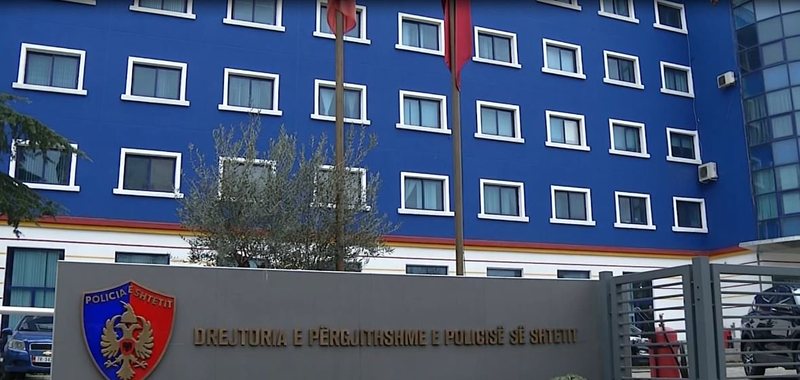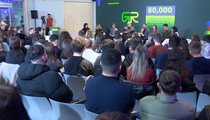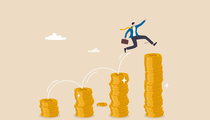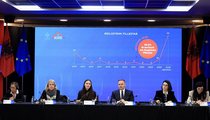35 years since the fall of the Berlin Wall - The values of 1989 and today's challenges of democracy

The Economist
Germany celebrated on Saturday the 35th anniversary of the fall of the Berlin Wall, which for decades divided West and East Germany. The fall of the wall, which separated the Communist East from the capitalist West for almost 3 decades and became the main symbol of the Cold War, was followed by the reunification of Germany a year later in 1990.
It's not often that a landmark announcement comes as an afterthought, almost by accident, at the end of a grueling media conference. But this was exactly how the communist government of East Germany told a disbelieving world that the Berlin Wall, the most powerful symbol of the Cold War, would be opened after nearly three decades.
Guenther Schabowski, the former top communist East German official who accidentally announced the opening of the Berlin Wall, was speaking at a boring press conference on November 9, 1989, when he was asked by a reporter about travel regulations.
For months, pressure had been mounting on the East German government to give its citizens the freedom to travel to the West. Schabowski, clearly unprepared, surprised the journalists present with his answer that the border points are open.
It was later revealed that the announcement was not due to be made public until 4am the next day. Schabowski also intended to say that East Germans could apply for visas regularly at the relevant state agency.
But his confusing habits turned into a political bombshell for the seniors. Journalists immediately began reporting that the Wall, long the most powerful symbol of the Iron Curtain and the Cold War dividing East and West, was open, prompting immense joy among East Germans.
On the occasion of the 35th anniversary of the fall of the Berlin Wall, Germany's capital held concerts, art installations and official events commemorating one of the country's most historic days in the 20th century. It was "a very lucky day for which we Germans are still grateful today," said Chancellor Olaf Scholz, speaking on the occasion.
Built in 1961, the Berlin Wall stood for 28 years on the front lines of the Cold War between the Americans and the Soviets. It was built by the Communists to isolate East Germans from the supposed ideological contamination of the West and to stem the tide of people fleeing East Germany.
The Berlin Wall had carved out a border 156.4 kilometers long, winding through the heart of Berlin and the surrounding countryside. However, when the border opened 35 years ago, it took less than a year until German reunification on October 3, 1990. Today, only a few sections of the wall remain, serving mainly as a tourist attraction.
For the 35th anniversary celebrations, event organizers created a temporary wall of 5,000 posters designed by children and adults under the motto "we support freedom", which attracted a large influx of visitors, including many foreign tourists. This installation spanned about 4 kilometers of the former wall in the center of Berlin.
The posters combine the demands of East German protesters against the communist authorities in the autumn of 1989, such as freedom of expression, freedom of the press and freedom of travel, with the wishes of today and were created as part of works in schools, churches, local groups artistic and cultural projects.
"I stand for freedom, because without freedom everything else is nothing," said Berlin Mayor Kai Wegner at the official event, accompanied by the President of Germany, Frank-Walter Steinmeier, at the Berlin Wall Memorial.
But how did the Berlin Wall fall?
US President Ronald Reagan, commemorating the 750th anniversary of the city of Berlin, spoke at the Brandenburg Gate military base near the Berlin Wall on June 12, 1987. Because of the amplification system being used, Reagan's words could be heard in East Berlin.
During his speech, the American president said the famous sentence; "Tear down this wall!", addressing the Soviet leader, Mikhail Gorbachev. Reagan's speech that day is considered by many to be the beginning of the end of the Cold War, which culminated in the collapse of the Soviet Union.
In the late 1980s, the power of the Soviet Union began to waver, especially when Gorbachev became General Secretary of the Communist Party in 1985. He abandoned the Brezhnev Doctrine, a central political tenet of Soviet foreign policy, which called for limited sovereignty of Warsaw Pact.
This allowed the Eastern Bloc countries to change their foreign policies and on May 2, 1989, Hungary dismantled its border fence, creating the first crack in the Iron Curtain.
In East Germany, a growing movement and a wave of emigration to the West forced the dictatorship to end in 1989. A new travel law mistakenly announced on November 9, 1989, led to an influx of people to brought down the Berlin Wall.
The crossing called "Bornholmer Strasse" in Berlin was the first to open that night. The border guards, who had not received orders to stop those who intended to cross, surrendered under the pressure of a large crowd. Gradually, new crossing points were created, leaving behind large spaces in the Wall. Border soldiers, on the other hand, began dismantling fences and other obstacles.
In June 1990, the systematic dismantling of the Wall began and the concrete pieces were sold around the world. Some sections were put under protection as historical monuments.
The fall of the Berlin Wall paved the way for German reunification on October 3, 1990, less than a year after the border reopened. The destruction of the Wall was completed in 1994.
The longest remaining part of the Wall in Berlin is currently in the so-called "East Side Gallery", where the once gray concrete slabs are covered with murals that were painted by 118 artists after the border opened.
One of the most famous - and most visited - crossings commemorating the Berlin Wall - is Checkpoint Charlie.
The historic border crossing controlled by the United States between East and West stood for three decades. There, Allied guards registered members of the American, British and French forces before trips to East Berlin, and foreign tourists could learn about their stay there.
In October 1961, it famously became the scene of a tank confrontation between American and Soviet forces who took up positions and faced each other. The checkpoint booth was removed on June 22, 1990, about half a year after the wall opened. The original stand is now on display at the Allied Museum in Berlin-Zehlendorf.
The world, however, has changed dramatically in the decades since November 9, 1989. In many regions across Europe, Western values are being questioned and support for populist parties is on the rise. And as Germany commemorates the 35th anniversary of the fall of the Berlin Wall, the celebrations serve not only as a reminder of the power of the Peaceful Revolution and peaceful protests, but also as a guide to not allow the perspectives of the past to return.

Turkey fines Amazon with 2 million lira for data breach!
Turkey's Personal Data Protection Board (KVKK) has fined Amazon.com, launching new gaming platform Twitch, 2 million liras ($58,000) for a data breach, the......

How much income goes to rent for minimum wage citizens in Europe?
"Housing, water, electricity and gas" accounted for the largest share of household expenditure in the EU. In 2022, almost a quarter of all household......

The Dutch government avoids collapse after the resignation of the secretary of state!
The Dutch government dominated by far-right leader Geert Wilders has survived - for now - a government crisis that centered on the resignation of the finance......

Gas prices rise after Gazprom stops deliveries to Austria!
Gazprom Export has announced that it will stop gas supplies to Austria after more than 50 years, from November 16. This follows Austria's largest fossil fuel......

China's Fertility Decline - Challenges and New Policies Aiming to Boost Fertility
China's efforts to raise birth rates must still address the underlying causes of their rapid decline, analysts point out. Although the country began easing......

Britain, £2bn for undersea cable - New link offers clean energy, reduces gas dependency
British energy regulator Ofgem has approved a £2 billion funding package to build around 200 kilometers of new submarine and underground cables linking......

Is the investigation continuing in the aesthetic centers? - Ndoi: We are at the stage where statements are received from the subjects
A short time ago, the police undertook an action where they hit the aesthetic centers that developed their activity with contraband goods. In an interview......

Private pension funds "gain more ground" - Almost 14% more members than last year. Assets reach new record
In conditions where the state pension does not provide sufficient income to cover living costs, the market of private pension funds is gaining more and more......





















